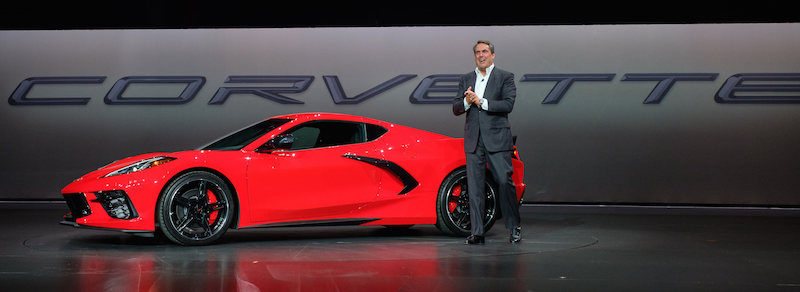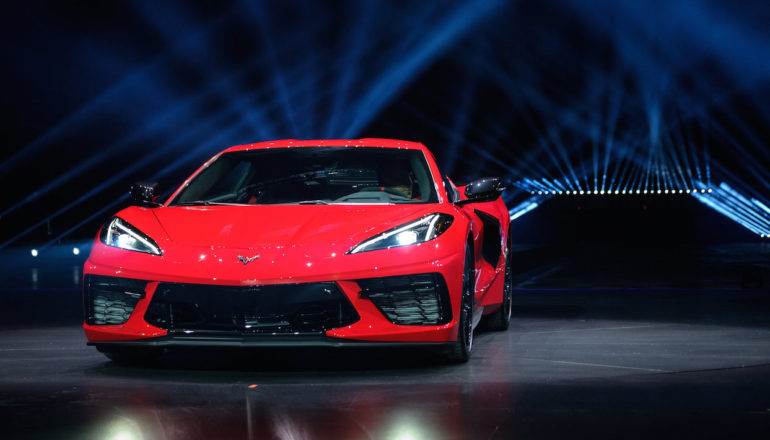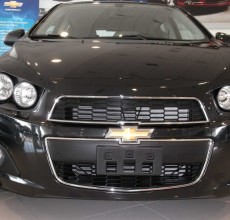2020 Stingray is reimagined to be Chevrolet’s first-ever production mid-engine Corvette. It is the sum of everything that came before it and then some more. If the Press Release is any indication, the fastest and most powerful Corvette ever will introduce us to new levels of performance, technology, craftsmanship and luxury. Amidst many firsts, the Corvette will now be available in left- and right-hand-drive variants.

General Motors President Mark Reuss drives the 2020 Chevrolet Corvette Stingray onto the stage during its unveiling Thursday, July 18, 2019 in Tustin, California.
So what demanded the transformation? As GM President Mark Reuss puts it, “The traditional front-engine vehicle reached its limits of performance, necessitating the new layout. In terms of comfort and fun, it still looks and feels like a Corvette, but drives better than any vehicle in Corvette history.”
The advantages of the new mid-engine layout
Better weight distribution: The rear weight bias will enhance performance on a straight line and on the track.
Better responsiveness: Sitting closer to the front axle, almost on top of the front wheels, will mean a better sense of control.
Fastest entry Corvette ever: When equipped with Z51 Performance Package, the new Corvette will get to 0-60 mph (0 – 96 kmph) in less than three seconds.
Better view: The hood, instrument panel and steering wheel follow a lower profile giving the new Corvette a race car-like view of the road.
Better practicality: With no engine to fill, the Corvette gets a second trunk. They add up to 12.6 cubic feet of cargo volume – two sets of golf clubs or enough equipment for a mini photography trip.

Design inspired by racing and aeronautics
The Press Release reads thus: “True to its aeronautical and racing roots, the 2020 Stingray’s canopy-forward stance was inspired by F22s, F35s and other modern fighter jets and Formula One racing. Other classic Corvette signatures adapted to the Stingray include a distinctive face that communicates the purpose of the vehicle’s mission, a classic horizontal crease, aggressive front fenders and familiar positioning of the dual-element headlamps.”
The focal point of the car’s new design is of course the newly placed engine that sits ‘like a jewel in a showcase’ visible through the large rear hatch window. The close attention to detail makes every wire, tube, bolt and fastener look good in the overall design scheme as they would in modern track and all-road motorcycle design.
Some of the design details:
Low profile headlamps designed around all-new projectors
The door, hood and hatch releases are totally hidden and do not disrupt the sculpted design
Large side air intakes for engine cooling and aerodynamic performance
The A-pillar is shaped to convey speed and improve visibility
Large rear hatch that showcases the engine with seven air vents
Quad exhaust tips located on the vehicle’s outboard ends
Dual-element LED tail lamps with animated turn signals
Enhancements in interior:
The cockpit has moved forward by 16.5 inches (about 1 1/3 foot). The vertical climate controls and ultra-thin vents minimize the height of the instrument panel, creating a low yet spacious aeronautically styled interior. The new two-spoke steering wheel is squared-off and small, enabling an unobstructed view of the 12-inch reconfigurable cluster display.
The 2020 Stingray showcases hand-wrapped, cut-and-sewn leather, plenty of stainless steel, as seen on the speaker grilles of its Bose Performance Series audio system, and of course, carbon fibre trim as seen on the GT2 and Competition sports seats.
The new Corvette also offers the most personalization options ever with up to a dozen colours for exteriors, interiors, seat belts and stitch packages. The three new introductions are interestingly named – Rapid Blue, Zeus Bronze and Accelerate Yellow. The new Corvette interiors offer three seat styles, too – GT1, a sporty style that emphasizes comfort; GT2, a racing-inspired design with no compromise on long-distance comfort; and Competition Sport for the serious track-focused driver, with aggressive bolsters, full Napa seating surfaces and carbon fiber trim on the headrest, heating and ventilation, along with an all-new durable performance textile inspired by Kevlar vests.

Engineered to be a supercar for every day
“Our mission was to develop a new type of sports car, combining the successful attributes of Corvette with the performance and driving experience of mid-engine supercars,” said Tadge Juechter, Corvette executive chief engineer.
So, Corvette’s structure is built around its backbone: the center tunnel. This enables a light, stiff structure to serve as the foundation for the suspension system to perform in an optimized manner. The car promises outstanding lateral grip, excellent stability due to a low center of gravity, and a connected-to-the-road feel with minimal vibrations at high speeds or on long road trips.
Corvette’s roof panel can still be removed and stored in the rear trunk while the engine-free front storage compartment can make space for an airline-spec carry-on and a laptop bag. The seat offer more comfort can be pushed an extra inch rearward, and offers almost double the reclining angle.
Smart mixed-materials strategy
- Six high-pressure diecast aluminum parts minimize the number of joints making a stiffer structure for better handling – they are also called the Bedford Six, manufactured at GM Powertrain in Bedford, Indiana
- Industry-first carbon fiber curved rear bumper beam
- Front and rear trunk tubs and dashboard molded from ultra-lightweight “float” derived from fiberglass and a proprietary resin – it can actually float in water.
Ride and handling highlights
- Steering ratio improved from 16.25:1 to 15.7:1. New eBoost brakes that are more precise and tunable.
- The new seating position places the car’s center of gravity close to the driver’s inside hip, so the car literally turns around the driver.
- The first sports car application of Michelin’s all-season performance tire that can corner at nearly 1G.
- Front suspension lift that raises ground clearance by approximately 40mm at the front bumper in 2.8 seconds, protecting against bumps, potholes, steep driveways and other challenges on the road. It can operate at speeds of up to 38.6 kmph and can memorizing up to 1,000 locations on GPS and automatically adjust the next time the car passes through.
- Rear weight distribution favourable to get off the line quicker during launch control
- Z51 Performance Package whose highlights are performance suspension with manually adjustable threaded spring seats, larger brake rotors, enhanced cooling, performance exhaust and specific axle ratio.
- An electronic limited slip differential that modulates torque between the rear tires for incredible vehicle stability.
- A front splitter and open two-piece rear spoiler that add up to a combined 181.5 kg of downforce.
- Available Magnetic Ride Control 4.0, which gathers data from the road better through suspension-mounted accelerometers, and responds faster to it for a smoother ride
- Available Performance Traction Management.

Natural V8 and an 8-speed Dual Clutch
2020 Stingray is driven by Chevy’s next-generation 6.2 L Small Block V-8 LT2 engine, the only naturally aspirated V-8 in the segment, with a never-before output of 495 horsepower and 637 Nm of torque when equipped with performance exhaust.
Jordan Lee, GM’s global chief engineer of Small Block engines, says “The LT2 has been designed to deliver excellent low-end torque and high-end power to give thrilling pedal response at any RPM.”
For the first time ever, the base Stingray will use an engine-mounted dry sump oil system and three scavenge pumps for improved track performance. So, oil volume remains high to live up to improved lateral acceleration levels exceeding 1G in all directions.
Chevrolet’s first eight speed dual-clutch transmission is uniquely designed with manual specialist TREMEC Corporation to ensure the spirited, direct connected feeling of a manual while providing the premium driving comfort of an automatic. The double-paddle de-clutch feature even allows the driver to disconnect the clutch by holding both paddles for more manual control. “The performance shift algorithms are so driver-focused, they can sense when you’re doing spirited driving — regardless of driving mode — and will hold lower gears longer for more throttle response,” said Juechter.
All-new technology improves performance and usability
Driver mode choices move from four to six. Besides the familiar Weather, Tour, Sport and Track modes, there are two new modes: MyMode, a configurable setting and Z mode, named after the famed Z06, ZR1 and Z51 Corvette performance packages. This is a single-use mode that is activated through a “Z” button on the steering wheel and allows drivers to adjust the engine and transmission as well.
Digital age transformation
The 2020 Stingray benefits from GM’s new digital vehicle platform, an all-new electronic architecture that minimizes wiring while allowing for faster signal transmission between different vehicle systems and the higher resolution screens. The platform enables continuous vehicle improvements through over-the-air updates and enhanced cybersecurity measures.
One-touch Bluetooth pairing with Near Field Communication is a first for Chevy while other tech features include wireless charging, learn-as-you-go voice recognition, and a new 12-inch customizable instrument cluster and a tire fill alert that warns when the tires are filled to the maximum pressure. The Corvette also features an industry-pioneering Performance Data Recorder, an advanced driving analysis tool upgraded with high-definition resolution camera and a new, in-vehicle user interface.
For now, we know that the 2020 Chevrolet Corvette Stingray goes into production at GM’s Bowling Green Assembly later this year and starts under USD 60,000. For the pricing and package details, we will have to wait.
(Photos by Steve Fecht for Chevrolet, taken on July 18, 2019 in Tustin, California.)














